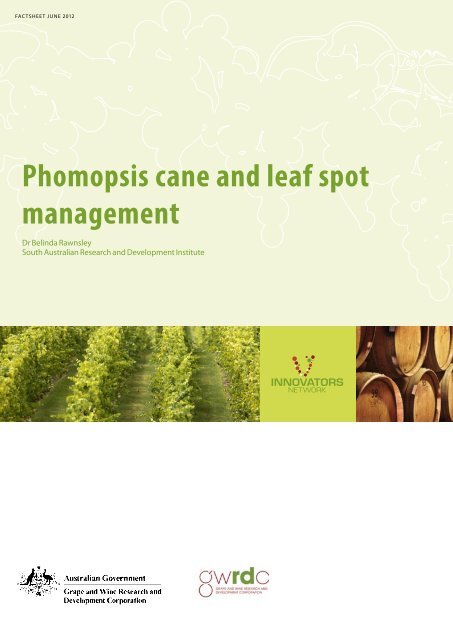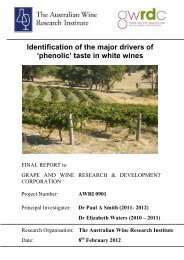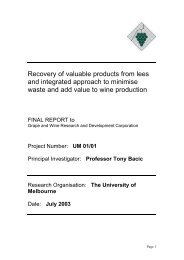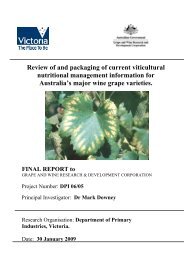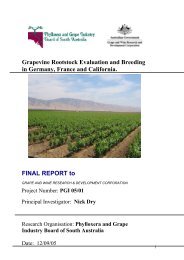Phomopsis cane and leaf spot management - GWRDC
Phomopsis cane and leaf spot management - GWRDC
Phomopsis cane and leaf spot management - GWRDC
You also want an ePaper? Increase the reach of your titles
YUMPU automatically turns print PDFs into web optimized ePapers that Google loves.
FACTSHEET JUNE 2012<br />
<strong>Phomopsis</strong> <strong>cane</strong> <strong>and</strong> <strong>leaf</strong> <strong>spot</strong><br />
<strong>management</strong><br />
Dr Belinda Rawnsley<br />
South Australian Research <strong>and</strong> Development Institute
Introduction<br />
<strong>Phomopsis</strong> <strong>cane</strong> <strong>and</strong> <strong>leaf</strong> <strong>spot</strong> (<strong>Phomopsis</strong>) of grapevine is<br />
caused by the fungus <strong>Phomopsis</strong> viticola. <strong>Phomopsis</strong> infects<br />
grapevines grown in many viticulture regions of Australia<br />
but has not been reported in Western Australia. <strong>Phomopsis</strong><br />
develops during wet springs when spores are spread by rain<br />
splash. Infection appears as elongated cracks on shoots, <strong>leaf</strong><br />
<strong>spot</strong>s <strong>and</strong> bleached <strong>cane</strong>s. Cool wet weather <strong>and</strong> prolonged<br />
<strong>leaf</strong> wetness increase the appearance <strong>and</strong> severity of<br />
<strong>Phomopsis</strong> symptoms. Crop loss occurs as a result of girdling<br />
at the base of shoots, weakening <strong>and</strong> cracking of <strong>cane</strong>s,<br />
which consequently lowers vine productivity. Yield loss can<br />
also occur due to infection of bunch stems <strong>and</strong> berry rot.<br />
Disease cycle<br />
Winter<br />
The fungus overwinters in the buds, bark <strong>and</strong> <strong>cane</strong>s of<br />
infected vines. Spores are produced in black <strong>spot</strong>s (pycnidia)<br />
on bleached <strong>cane</strong>.<br />
Spring<br />
Spores are dispersed <strong>and</strong> infect new shoots in spring. At<br />
least 10 hours of rain at 16–20°C is favourable for spore<br />
production. For infection to occur, 6–8 hours of <strong>leaf</strong> wetness<br />
is required. Prolonged <strong>leaf</strong> wetness increases the severity of<br />
disease. Spores on the <strong>cane</strong> are spread by water <strong>and</strong> rainsplashed<br />
on to young, newly developed green shoots. Spores<br />
are moved about in water droplets blown from infected<br />
vines. Leaf <strong>spot</strong>s (brown with a yellow halo) usually appear<br />
about 21 days after an infection, while stem symptoms can<br />
take 28 days or more.<br />
Summer<br />
The fungus is relatively inactive during the hot dry summer<br />
months (above 30°C). The fungus can persist for several<br />
seasons in the vine <strong>and</strong>, if left untreated, infected <strong>cane</strong>s <strong>and</strong><br />
spurs may produce spores for around 3 years.<br />
Figure 1: In winter, <strong>Phomopsis</strong> causes bleached dormant <strong>cane</strong> with<br />
small black <strong>spot</strong>s.<br />
Risk assessment<br />
Seasonal conditions<br />
Spores need moist conditions to germinate <strong>and</strong> infect the<br />
vine. Prolonged periods of cool wet weather in spring create<br />
the greatest potential for crop losses from <strong>Phomopsis</strong>. The risk<br />
of <strong>Phomopsis</strong> infection is low if there are few extended rainfall<br />
periods in spring.<br />
Pruning system<br />
Pruning systems that retain high bud numbers <strong>and</strong> infected<br />
shoots from the previous season may assist in the build-up of<br />
<strong>Phomopsis</strong>.<br />
Vineyard <strong>and</strong> vine microclimate<br />
Vineyards with topographies that restrict airflow or vines that<br />
have dense canopies will be at greater risk of infection due to<br />
prolonged periods of wetness following rain events.<br />
Symptoms<br />
Winter<br />
In winter, infected <strong>cane</strong>s develop bleached white areas on<br />
speckled with small black <strong>spot</strong>s (Figure 1). These small black<br />
<strong>spot</strong>s (pycnidia) contain spores. Where severe infection<br />
has taken place, black cracks are also evident (Figure 2).<br />
Cane bleaching is not a reliable sole indicator of <strong>Phomopsis</strong><br />
infection, however, as bleaching can also be caused by a<br />
range of factors such as weather extremes <strong>and</strong> other types of<br />
fungi.<br />
Spring <strong>and</strong> early summer<br />
<strong>Phomopsis</strong> causes distinct, small <strong>leaf</strong> <strong>spot</strong>s, each surrounded<br />
by a yellow halo. Leaf <strong>spot</strong>s remain small <strong>and</strong> become<br />
numerous (Figure 3). Shoot symptoms appear as black<br />
elongated cracks on lower internodes (Figure 4). Lesions can<br />
coalesce, deepen <strong>and</strong> become large cracks that cause shoots<br />
to become girdled <strong>and</strong> break. Severely affected shoots are<br />
prone to wind damage <strong>and</strong> stunted growth. Table 1 provides<br />
a summary of <strong>Phomopsis</strong> <strong>cane</strong> <strong>and</strong> <strong>leaf</strong> <strong>spot</strong> symptoms.<br />
Figure 2: Black longitudinal cracks evident on bleached dormant<br />
<strong>cane</strong>.
Table 1: Checklist of symptoms for <strong>Phomopsis</strong> <strong>cane</strong> <strong>and</strong> <strong>leaf</strong> <strong>spot</strong>.<br />
Site Symptoms<br />
Leaves Leaf symptoms first appear in spring on the lower leaves of shoots.<br />
• Small dark brown <strong>spot</strong>s, usually less than 1 mm in diameter, with 2–3 mm of yellowish halo surrounding the<br />
brown <strong>spot</strong>.<br />
• Spots can become more numerous, but do not grow in size.<br />
• Leaves can distort as <strong>spot</strong>s darken <strong>and</strong> drop out.<br />
• Leaves with badly affected stems can turn yellow <strong>and</strong> fall.<br />
• Leaf petioles can have black <strong>spot</strong>s <strong>and</strong> lesions<br />
Green shoots • Small <strong>spot</strong>s with black centres develop, usually on the lower internodes, gradually exp<strong>and</strong>ing <strong>and</strong><br />
elongating to form black crack-like lesions up to 5–6 mm long.<br />
• Large numbers of merging <strong>spot</strong>s on badly infected shoots may give a ‘scabby’ or ‘corky’ appearance.<br />
• As <strong>cane</strong>s grow <strong>and</strong> harden, the fissures crack <strong>and</strong> scar.<br />
• Girdled shoots can fail to mature, or become stunted <strong>and</strong> die.<br />
• Severe infections can lead to dwarfing, deformation <strong>and</strong> death of infected shoots, which break off near<br />
the base.<br />
• Weakened older shoots (30–60 cm long) can break under a heavy crop load or in strong winds.<br />
Inflorescences<br />
<strong>and</strong> bunches<br />
Although this is not as common as foliar <strong>and</strong> shoot symptoms, <strong>Phomopsis</strong> can cause black speckled rotting of<br />
berries, particularly in cool wet conditions. Berry rot rarely occurs without prior <strong>leaf</strong> <strong>and</strong> shoot symptoms.<br />
• Flower cluster rachis develops <strong>spot</strong>s like those found on leaves.<br />
• Severely infected clusters wither.<br />
• If rain occurs just before harvest, previously uninfected berries can develop light brown <strong>spot</strong>s, which<br />
enlarge, blacken <strong>and</strong> exude yellowish spore masses.<br />
• These berries shrivel <strong>and</strong> become mummified.<br />
Lignified <strong>cane</strong>s • Infected <strong>cane</strong>s may be bleached white in winter.<br />
• Bleached areas, particularly those around the nodes, become speckled with small black <strong>spot</strong>s (the resting<br />
structures of the fungus).<br />
• These <strong>spot</strong>s are prominent in the cortices of infected one-year-old <strong>cane</strong>s, on spurs, bunch <strong>and</strong> berry stems,<br />
<strong>and</strong> tendrils.<br />
Figure 3: Small <strong>leaf</strong> <strong>spot</strong>s, each surrounded by a yellow halo.<br />
Figure 4: Lesions on green shoots.<br />
Monitoring<br />
Monitoring is critical to determining whether <strong>Phomopsis</strong><br />
is present in the vineyard. The majority of infection occurs<br />
during or shortly after budburst. Early detection <strong>and</strong><br />
knowledge of any previous infection are critical for control of the<br />
disease as first chemical sprays are required at 50% budburst<br />
to avoid infection of newly emerged shoots.<br />
Choosing monitoring sites<br />
Sheltered or low-lying parts of the vineyard <strong>and</strong>/or vines<br />
with dense canopies should be closely monitored. Vines with<br />
<strong>Phomopsis</strong> should be monitored for several years after the<br />
last recorded infection.<br />
How to sample<br />
In winter, look for bleached <strong>cane</strong>s <strong>and</strong> spurs, with <strong>and</strong> without<br />
scarring. In the growing season, symptoms can be seen from<br />
budburst onwards. Inspect 200 shoots, particularly in parts of<br />
the vineyard where disease has occurred in previous seasons,<br />
<strong>and</strong> in low-lying areas. Briefly examine leaves <strong>and</strong> lower<br />
internodes on shoots. Later in the season, inspect rachis <strong>and</strong><br />
bunches if long wet periods (20–30 hours) occur at flowering.
When to sample<br />
Begin monitoring for bleached <strong>and</strong> cracked <strong>cane</strong>s around<br />
4 weeks before budburst, particularly in areas where <strong>leaf</strong><br />
<strong>and</strong> shoot symptoms were observed in the previous season.<br />
If <strong>Phomopsis</strong> is suspected, <strong>cane</strong> samples can be sent to a<br />
diagnostic laboratory for confirmation. Infection occurs<br />
following 10 hours of rainfall at optimum temperatures<br />
of 16–20°C <strong>and</strong> prolonged <strong>leaf</strong> wetness, so monitor vines<br />
every 1–2 weeks from 3 weeks after budburst. Leaf <strong>spot</strong>s<br />
usually appear about 3 weeks after an infection period; stem<br />
symptoms can take 4 weeks or more.<br />
Confusion with other symptoms<br />
Diaporthe<br />
Symptoms appear as bleached white <strong>cane</strong>s speckled with<br />
small black <strong>spot</strong>s. Symptoms do not appear on green<br />
shoots or leaves. Diaporthe was once confused as a type of<br />
<strong>Phomopsis</strong> but Diaporthe is harmless.<br />
Chemical spray damage<br />
Numerous yellow <strong>leaf</strong> <strong>spot</strong>s appear on leaves where spray<br />
contact has occurred, but the <strong>spot</strong>s are larger than those of<br />
<strong>Phomopsis</strong>; no shoot lesions appear (Figure 5).<br />
Insect damage<br />
Yellow <strong>leaf</strong> <strong>spot</strong>s appear on leaves but these are often<br />
associated with <strong>leaf</strong> veins. No brown or black <strong>spot</strong>ting occurs<br />
on leaves.<br />
Black <strong>spot</strong> (anthracnose)<br />
Symptoms appear as brown-purple <strong>spot</strong>s that are typically<br />
larger than those of <strong>Phomopsis</strong>. Infections on green shoot are<br />
more circular with a roughened appearance (Figures 6a,b).<br />
Bud mite<br />
Leaves exhibit similar distortion <strong>and</strong> stunting to those seen<br />
with <strong>Phomopsis</strong> but without the <strong>leaf</strong> <strong>spot</strong>s. Mites can cause<br />
elongated scars on green shoots but these do not elongate.<br />
Figure 5: Chemical spray damage on leaves.<br />
a<br />
b<br />
Figure 6: Black <strong>spot</strong> symptoms can be confused with those of<br />
<strong>Phomopsis</strong> – a <strong>leaf</strong> <strong>spot</strong>s, b stem infection.<br />
Botrytis, Botryosphaeria, frost<br />
All can cause greyish bleaching of <strong>cane</strong>s but not cracking.<br />
Spotting on shoots or leaves does not occur.<br />
Management<br />
If the disease is not present in the vineyard, preventative<br />
treatment is not necessary. If the vineyard was infected in the<br />
previous season <strong>and</strong> an infection period is suspected, earlyseason<br />
fungicide applications are recommended. Do not wait<br />
for <strong>leaf</strong> <strong>and</strong> shoot symptoms to appear, as the infection has<br />
already occurred by this time.<br />
Chemical<br />
If <strong>Phomopsis</strong> is detected or has previously been a problem,<br />
appropriate registered fungicides (Table 2) must be applied<br />
before the fungus produces spores <strong>and</strong> has the chance to<br />
infect new growth. The chemicals available for <strong>Phomopsis</strong> are<br />
preventative only <strong>and</strong> do not have any curative properties.<br />
Therefore, the best time to apply chemical is before rainfall<br />
events during spring to prevent infection. Additional<br />
applications will be required if wet conditions persist, in order<br />
to protect new growth. Refer to http://www.awri.com.au/<br />
industry_support/viticulture/agrochemicals/agrochemical_<br />
booklet/ for details of products currently registered for use in<br />
Australian viticulture.
Table 2: Some recommended protectant fungicides registered for <strong>Phomopsis</strong> control in Australia<br />
Dormancy spray<br />
One application during dormancy (3–4 weeks before<br />
budburst) inhibits spore production. Note that there are long<br />
re-entry period restrictions with this approach.<br />
Spraying after budburst<br />
If <strong>Phomopsis</strong> infection has been a problem in the previous<br />
one or two seasons, a protectant fungicide should be applied<br />
at 50% budburst <strong>and</strong> 2 weeks after budburst. If wet conditions<br />
persist after budburst, further fungicide applications may be<br />
required to prevent further infection.<br />
Note that fungicides registered for <strong>Phomopsis</strong> are protectants<br />
only <strong>and</strong> do not have an effect if applied after disease<br />
symptoms appear. Consider fungicides with dual activity on<br />
other diseases such as Black <strong>spot</strong>, Botrytis <strong>and</strong> Downy mildew<br />
(see Table 3 for examples).<br />
Cultural<br />
Vineyard hygiene<br />
Active constituent(s) Activity group Example of registered product<br />
Fluazinam (dormancy spray only) 29 Shirlan<br />
Mancozeb M3 Mancozeb 750 WG<br />
Dithianon M9 Delan 700 WG<br />
Captan M4 Captan 900 WG<br />
Table 3: Some fungicides registered for use in Australian viticulture, with activity against <strong>Phomopsis</strong> <strong>and</strong> other fungal diseases.<br />
Active constituent(s)<br />
Always use clean grafting <strong>and</strong> planting material that is free<br />
from any pest or disease, including <strong>Phomopsis</strong>. Hot water<br />
treatment on dormant vine cuttings is effective at controlling<br />
infection in budwood <strong>and</strong> cuttings. Consider pruning out any<br />
infected <strong>cane</strong>s or mummified bunches during pruning where<br />
practical. Do not retain diseased spurs or <strong>cane</strong>s as fruiting<br />
wood for the following season.<br />
Removal of prunings<br />
Activity<br />
group<br />
Prune off diseased <strong>and</strong> dead wood from vines, <strong>and</strong> remove<br />
prunings from the vineyard floor (where practical) <strong>and</strong> bury or<br />
burn them to reduce the amount of inoculum.<br />
Example of registered product Other disease targets<br />
Captan + metalaxyl M4 + 4 Duplex WG Black <strong>spot</strong>, Botrytis, Downy mildew<br />
Copper sulphate tribasic<br />
+ mancozeb<br />
M1 + M3 Novofix Disperss Downy mildew<br />
Dithianon M9 Delan 700 WG Black <strong>spot</strong><br />
Captan M4 Captan 900 WG Black <strong>spot</strong>, Botrytis, Downy mildew<br />
Mancozeb M3 Dithane Rainshield Neo Tec Black <strong>spot</strong>, Downy mildew<br />
Metiram M3 Polyram DF Black <strong>spot</strong>, Downy mildew<br />
Modifying the vine/vineyard environment<br />
Canopy <strong>management</strong> practices can be used to encourage<br />
air movement, reduce humidity within the canopy, <strong>and</strong><br />
improve the penetration of sunlight <strong>and</strong> access for fungicide<br />
application, thereby reducing the risk of disease. This may<br />
include reducing vine vigour by pruning to reduce bud<br />
numbers, using foliage wires to lift <strong>and</strong> hold shoots, or<br />
removing excessive shoots or foliage. Large numbers of<br />
unpruned <strong>cane</strong>s (e.g. as a result of mechanical hedge pruning)<br />
can provide a significant source of inoculum for the following<br />
season.<br />
Further reading<br />
Erincik O, Madden LV, Ferree DC & Ellis MA (2003) Temperature<br />
<strong>and</strong> wetness-duration requirements for grape <strong>leaf</strong> <strong>and</strong><br />
<strong>cane</strong> infection caused by <strong>Phomopsis</strong> viticola. Plant Disease<br />
87(7): 832–840.<br />
Nicholas P, Magarey P & Wachtel M (eds) (1994) Diseases <strong>and</strong><br />
Pests, Grape Production Series No. 1, Winetitles: Adelaide.
Grape <strong>and</strong> Wine Research <strong>and</strong> Development Corporation<br />
Industry House, Cnr Botanic <strong>and</strong> Hackney Roads, Adelaide SA 5000<br />
PO Box 610, Kent Town SA 5071<br />
Telephone (08) 8273 0500<br />
Facsimile (08) 8373 6608<br />
Email gwrdc@gwrdc.com.au<br />
Website www.gwrdc.com.au<br />
Disclaimer: The Grape <strong>and</strong> Wine Research <strong>and</strong> Development Corporation (<strong>GWRDC</strong>)<br />
in publishing this fact sheet is engaged in disseminating information not rendering<br />
professional advice or services. The <strong>GWRDC</strong> expressly disclaims any form of liability<br />
to any person in respect of anything done or omitted to be done that is based on the<br />
whole or any part of the contents of this fact sheet.<br />
c<br />
wrdc<br />
AND WINE RESEARCH AND<br />
DEVELOPMENT CORPORATION<br />
cGRAPE


